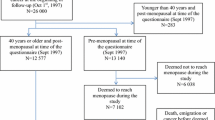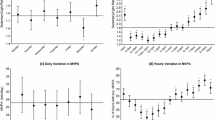Abstract
Objective
Obesity and physical inactivity are poor prognostic indicators for breast cancer. Studies to date have relied on self-report measures of physical activity, which tend mainly to assess moderate-to-vigorous intensity leisure-time physical activity. We report the cross-sectional associations of objectively assessed physical activity and sedentary time with adiposity in a sample of breast cancer survivors from the United States.
Methods
One hundred and eleven women from the National Health and Nutrition Examination Survey (NHANES) 2003–2004 and 2005–2006 reported a history of breast cancer. Participants wore an accelerometer for 7 days, and activity levels were summarized as moderate-to-vigorous intensity (accelerometer counts/min ≥1,952), light intensity (counts/min 100–1,951), and sedentary time (counts/min <100). Anthropometric measures were taken by study staff at examination centers.
Results
Participants spent the majority of their day in sedentary time (66%) or in light intensity activities (33%). Log moderate-to-vigorous intensity physical activity was negatively associated with adiposity (waist circumference β = −9.805 [95% CI: −15.836, −3.775]; BMI β = −3.576 [95% CI: −6.687, −0.464]). Light intensity physical activity was negatively associated with adiposity; however, the fully adjusted models did not retain statistical significance. Similarly, sedentary time was positively associated with adiposity, but the fully adjusted models were not statistically significant.
Conclusions
This is the first study to describe the objectively assessed physical activity and sedentary time of breast cancer survivors. Increasing moderate-to-vigorous and light intensity physical activity, and decreasing sedentary time, may assist with weight management and improve other metabolic health outcomes for breast cancer survivors.
Similar content being viewed by others
References
Chlebowski R, Aiello E, McTiernan A (2002) Weight loss in breast cancer patient management. J Clin Oncol 20:1128–1143
Holmes M, Chen W, Feskanich D, Kroenke C, Colditz G (2005) Physical activity and survival after breast cancer diagnosis. JAMA 293:2479–2486
Ball K, Owen N, Salmon J, Bauman A, Gore C (2001) Associations of physical activity with body weight and fat in men and women. Int J Obesity 25:914–919
Sallis J, Saelens B (2000) Assessment of physical activity by self-report: status, limitations, and future directions. Res Q Exerc Sport 71:1–14
International Agency for Research on Cancer (2001) Weight control and physical activity. IARC handbooks for cancer prevention. IARC Press, Lyon, p 2
Donahoo W, Levine J, Melanson E (2004) Variability in energy expenditure and its components. Curr Opin Clin Nutr 7:599–605
Harris T, Owen C, Victor C, Adams R, Ekelund U, Cook D (2009) A comparison of questionnaire, accelerometer, and pedometer: measures in older people. Med Sci Sport Exer 41:1392–1402
Hamilton M, Healy G, Dunstan D, Zderic T, Owen N (2008) Too little exercise and too much sitting: inactivity physiology and the need for new recommendations on sedentary behavior. Curr Cardiovasc Risk Rep 2:292–298
Dunstan D, Salmon J, Healy G et al (2007) Association of television viewing with fasting and 2-h postchallenge plasma glucose levels in adults without diagnosed diabetes. Diabetes Care 30:516–522
Howard R, Freedman D, Park Y, Hollenbeck A, Schatzkin A, Leitzmann M (2008) Physical activity, sedentary behavior, and the risk of colon and rectal cancer in the NIH-AARP diet and health study. Cancer Cause Control 19:939–953
Patel A, Rodriguez C, Pavluck A, Thun M, Calle E (2006) Recreational physical activity and sedentary behavior in relation to ovarian cancer risk in a large cohort of US women. Am J Epidem 163:709–716
Friberg E, Mantzoros C, Wolk A (2006) Physical activity and risk of endometrial cancer: a population-based prospective cohort study. Cancer Epidem Biomar 15:2136–2140
Wolin K, Colangelo L, Chiu B, Ainsworth B, Chatterton R, Gapstur S (2007) Associations of physical activity, sedentary time, and insulin with percent breast density in Hispanic women. J Womens Health 16:1004–1011
Wijndaele K, Lynch B, Owen N, Dunstan D, Sharp S, Aitken J (2009) Television viewing time and weight gain in colorectal cancer survivors: a prospective population-based study. Cancer Causes Control 20:1355–1362
Centers for Disease Control and Prevention (CDC) National Center for Health Statistics (NCHS). NHANES 2003–2004 and 2005–2006 data files: data, docs, codebooks, SAS code. 2009: NCHS
Matthews C, Chen K, Freedson P et al (2008) Amount of time spent in sedentary behaviors in the United States, 2003–2004. Med Sci Sport Exer 167:875–881
Craig C, Marshall A, Sjostrom M et al (2003) International physical activity questionnaire: 12-country reliability and validity. Med Sci Sport Exer 35:1381–1395
Freedson P, Melanson E, Sirard J (1998) Calibration of the computer science and applications, Inc. accelerometer. Med Sci Sport Exer 30:777–781
Willett W, Stampfer M (1986) Total energy intake: implications for epidemiologic analyses. Am J Epidem 124:17–27
Agricultural Research Service, Beltsville Human Nutrition Research Center, Food Surveys Research Group, and USDA. Food and Nutrient Database for Dietary Studies, 3.0 Hyattsville, MD
Troiano RP, Berrigan D, Dodd KW, Masse LC, Tilert T, McDowell M (2008) Physical activity in the United States measured by accelerometer. Med Sci Sport Exer 40:181–188
Owen N, Bauman A, Brown W (2009) Too much sitting: a novel and important predictor of chronic disease risk? Brit J Sport Med 43:81–82
Carmichael A (2006) Obesity as a risk factor for development and poor prognosis of breast cancer. BJOG-Int J Obstet Gy 113:1160–1166
Herman D, Ganz P, Petersen L, Greendale G (2005) Obesity and cardiovascular risk factors in younger breast cancer survivors: the cancer and menopause study (CAMS). Breast Cancer Res Tr 93:13–23
Irwin M, Aiello E, McTiernan A et al (2007) Physical activity, body mass index, and mammographic density in postmenopausal breast cancer survivors. J Clin Oncol 25:1061–1066
Van Pelt R, Evans E, Schechtman K, Ehsani A, Kohrt W (2001) Waist circumference vs body mass index for prediction of disease risk in postmenopausal women. Int J Obesity 25:1183–1188
Evenson KR, Terry JW (2009) Assessment of differing definitions of accelerometer nonwear time. Res Q Exerc Sport 80:355–362
Acknowledgments
The authors thank Dr. Charles Matthews (Nutritional Epidemiology Branch, National Cancer Institute) for the provision of, and expertise relating to, the accelerometer data reduction syntax. Lynch is supported by NHMRC Program Grant funding (#301200); Dunstan is supported by a Victorian Health Promotion Foundation Public Health Research Fellowship; Healy is supported by a NHMRC (#569861)/National Heart Foundation of Australia (PH 08B 3905) Postdoctoral Fellowship; Eakin is supported by a NHMRC Senior Research Fellowship (#511001); Owen is supported by a Queensland Health Core Research Infrastructure grant and by NHMRC Program Grant funding (#301200).
Author information
Authors and Affiliations
Corresponding author
Rights and permissions
About this article
Cite this article
Lynch, B.M., Dunstan, D.W., Healy, G.N. et al. Objectively measured physical activity and sedentary time of breast cancer survivors, and associations with adiposity: findings from NHANES (2003–2006). Cancer Causes Control 21, 283–288 (2010). https://doi.org/10.1007/s10552-009-9460-6
Received:
Accepted:
Published:
Issue Date:
DOI: https://doi.org/10.1007/s10552-009-9460-6




